Summer shoe test: Ten neoprene shoes for protection against shells, stones and co.
Tobias Frauen
· 18.07.2025






They don't appear in any injury statistics, but have probably ruined more surfing days than all serious injuries put together: all the cuts, wounds and bruises that you get on your feet in the course of your surfing life. Surfing barefoot is the best option for many, provided the temperatures allow it. Direct contact with the board is undoubtedly the best, with nothing slipping or constricting. However, if the beach and entry point are peppered with sharp rocks or there are shells, corals or other sharp obstacles lurking under the water, there is sometimes no way around surf shoes.
For many, it's also a question of habit: if you often surf with shoes, you feel a bit naked without them. For this reason, some freestylers often ride in shoes, including Niclas Nebelung. "I really like surfing with shoes, partly because of the injury prevention and partly because of the better grip," he says. "I used to ride without shoes, but after several hours of long sessions I had open sores, and surfing with pain is no fun." Another plus point for Niclas: with surf shoes, you can be a little more "rustic" when threading into the straps because the toes are protected - an advantage for freestylers, especially when switching to the switch position.
Good shoes offer grip and protection
What makes good surf shoes for Niclas? "I've found that they break quickly if they don't have thicker rubber on the toes," says Niclas. "In addition, the sole and the material on the top shouldn't be too thick, otherwise the feel is lost." For him, 2.5 millimetres of neoprene is the optimum. "I can only see advantages - however, shoes aren't as visually appealing when surfing, but you have to get over it!"
I really like surfing with shoes - because of the injury prevention and more grip." (Niclas Nebelung, freestyle pro)
Dennis Müller, another convinced shoe wearer, sees it the same way: "It's sometimes ridiculed, but protection is more important!" He sees this time and again at his kids' camps when participants are unable to get on the water due to injuries to their feet. "If they are good shoes with a rather thin sole, then I have the same grip and still have a good feel for the board!"
This is how we tested
We tried out a total of ten pairs of thin summer shoes during our test in Tobago. We always wore two different shoes at the same time so that we could immediately feel the differences. In addition, some guest testers also tried out the shoes in the shoe shop. The focus was not on thermal insulation, but on wearing comfort and protection from stones and shells. Even on the North Sea, Baltic Sea or Mediterranean, you don't need to worry about cold feet in the summer months. And with a shaft that is for the most part only hinted at, or even as a low shoe, these models are not a total visual failure either.
Elasticated drawstring and Velcro straps
The disadvantage of a low cut is the ingress of sand on the way to the water. The foot sinks into the beach and the sand trickles into the top of the shoe, which then rubs painfully against the foot on the water. Many test models therefore have elasticated straps at the top to keep the openings as small as possible. This also keeps unnecessary amounts of water out.
Surf shoes make life at spots with stones and shells more pleasant - no careful balancing, no painful cuts." (Tobi Frauen, surf editor)
Velcro straps over the instep of some models are designed to prevent the foot from slipping inside the shoe. For many barefoot fans, this is an exclusion criterion if the shoe gets stuck halfway into the strap, but the foot still doesn't have enough support and is uncomfortably compressed at the front. Whilst some manufacturers rely on tried and tested Velcro straps, others try a firm rubber reinforcement. Remarkable: The ION shoe, which impressed with the best fit in the test, manages without any straps at all.
A good compromise is required for the sole. Thin enough to provide sufficient feel for the board, but thick enough to protect the foot from shells, stones and other sharp objects. Also important: how far up around the toes does the sole extend to protect not only from below, but also if you hit your toes on rocks while walking (ouch!)? While some models offer only minimal protection, Ascan in particular has extended the rubber far up the instep. This also softens rough contact with fins or foils.
A good surf shoe offers just as much feeling as barefoot." (Dennis Müller, coach)
Split toe - toe separators yes or no?
Split-toe models are the flip-flops among surf shoes, with a bridge separating the big toe from its four little mates. We tested two "Splittys". Whether you consider these models is primarily a question of personal taste. While the separation is almost invisible on Ascan, XCEL only has a thin floating skin. In cold temperatures, the solitary big toe can get cold more quickly in its dark cave; this problem is obsolete in summer. The bridge, on the other hand, can also provide a little more support in the shoe if it fits well.
Trying on absolutely desired
We requested a size 46 for testing; some manufacturers only offer their models in double sizes, which of course makes a perfect fit more difficult. But even with the right shoe size, trying on is essential. A size 46 foot can also be narrow or wide, with a dominant big toe (as with the tester's foot) or toes of equal length. Does the little toe stretch outwards brashly, or does it lie bashfully and half-hidden under its neighbour? All of this can be decisive for the fit and the individual wearing comfort.
Ascan Beach
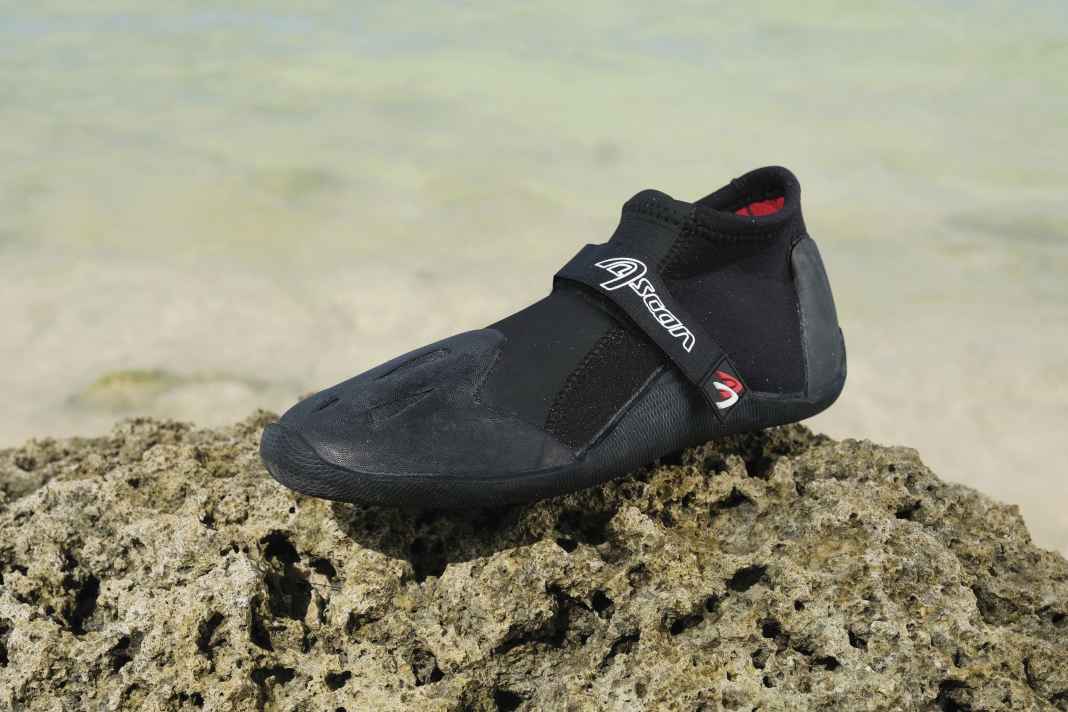



- Price: 37,90 >> available here
- Neoprene: 2 mm
- Sizes: 35/36 - 47/48
The Ascan shoe is one of the cheapest models in the test, but has almost all the essential features. It sits quite tightly on the foot in the double size 45/46, but even the Velcro strap can't completely prevent a little slipping inside the shoe without being pulled tight. The elasticated cuff is rather loose, allowing water and sand to seep into the shoe almost unhindered and become uncomfortable when surfing. The relatively thick sole offers good protection, but provides a little less feel for the board than other models. The heel is just as well reinforced as the toe area, with a reinforcement extending far up the instep. Top value for money for occasional use!
Good protection
Sits very loosely at the top
-
Ascan Star Splitty
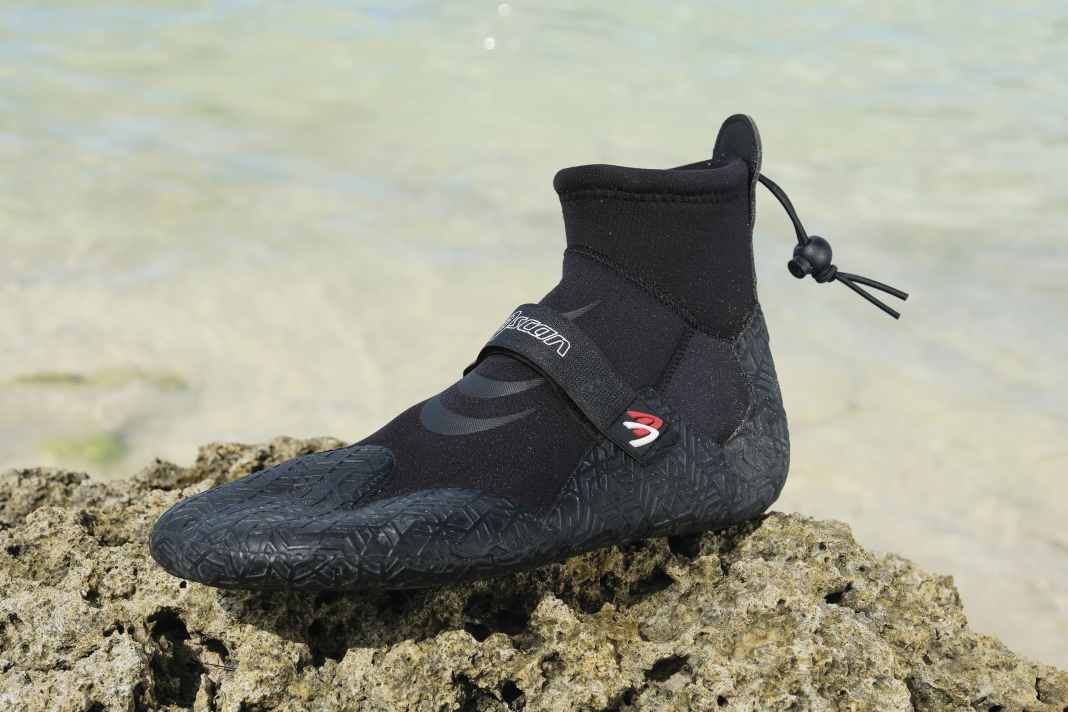



- Price: 45,90 >> available here
- Neoprene: 3 mm
- Sizes: 35/36 - 47/48
One of the two split-toe shoes in the test is barely recognisable as such, as the separator is located inside the otherwise plain shoe. As a result, the toes are close together and you can only feel the separation to the extent that you hardly slip around in the shoe. The sole is solid and provides good grip, but also relatively little feedback from the ground. The rubber of the sole is pulled up to the instep and protects the entire front area of the foot very well, even against dangers from above such as the fin. If in doubt, the foot strap needs to be adjusted a little further, as the tread extends up to the instep. The high shaft makes the shoe suitable for use all year round, while an additional elasticated band at the top prevents water and sand from getting in.
Good protection, also on the instep
Less feel
High shaft
GunSails Neo Shoes 2,5mm
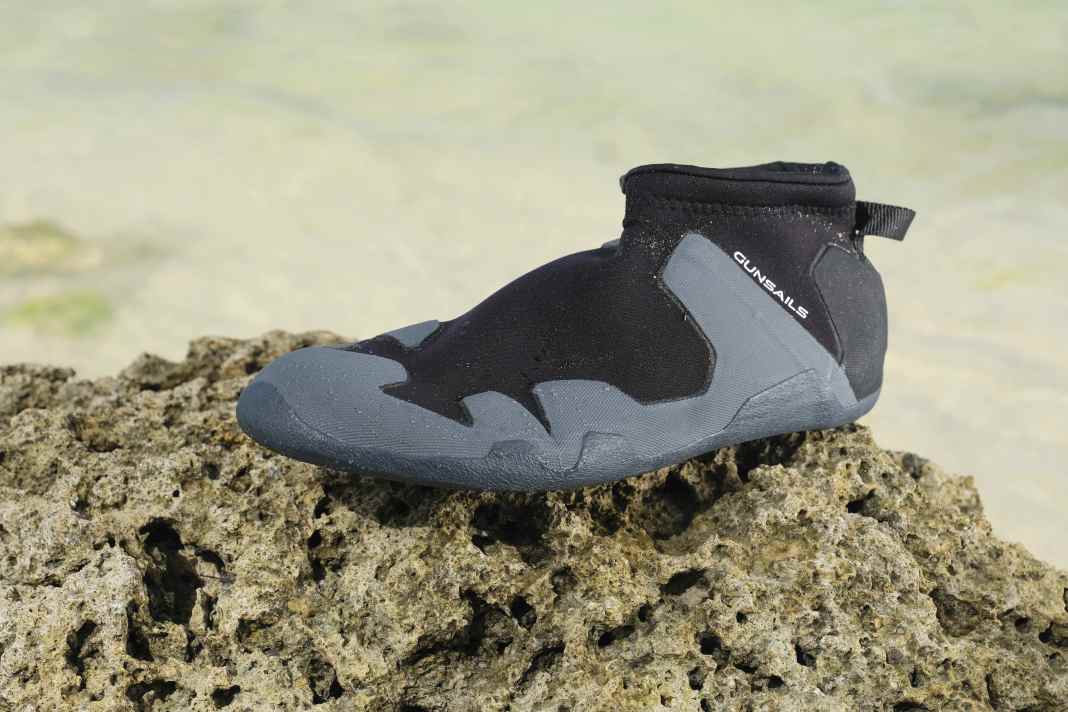



- Price: 39,90
- Neoprene: 2.5 mm
- Sizes: 37 - 45/46
The GunSails model is the only surf shoe in the test to have the elasticated cuff at an angle to the front, so that it doesn't get in the way when starting out in the water - that's definitely a plus point! The sole is solid and pulled upwards in places both in the toe area and on the sides. At the same time, it still provides sufficient feel for the board. The shoe has a rather narrow cut and fits tightly, especially at the front - possibly too tightly depending on the shape of your foot. Because there is only a hint of reinforcement instead of a Velcro strap, the shoe slides forwards and backwards a little. The strap at the heel helps you to put the shoe on and take it off, and the well-sealed cuff prevents water and sand from getting into the shoe.
Rubber strap to the front, good compromise between protection and feel
-
narrow cut
ION Plasma 2.5 Round Toe
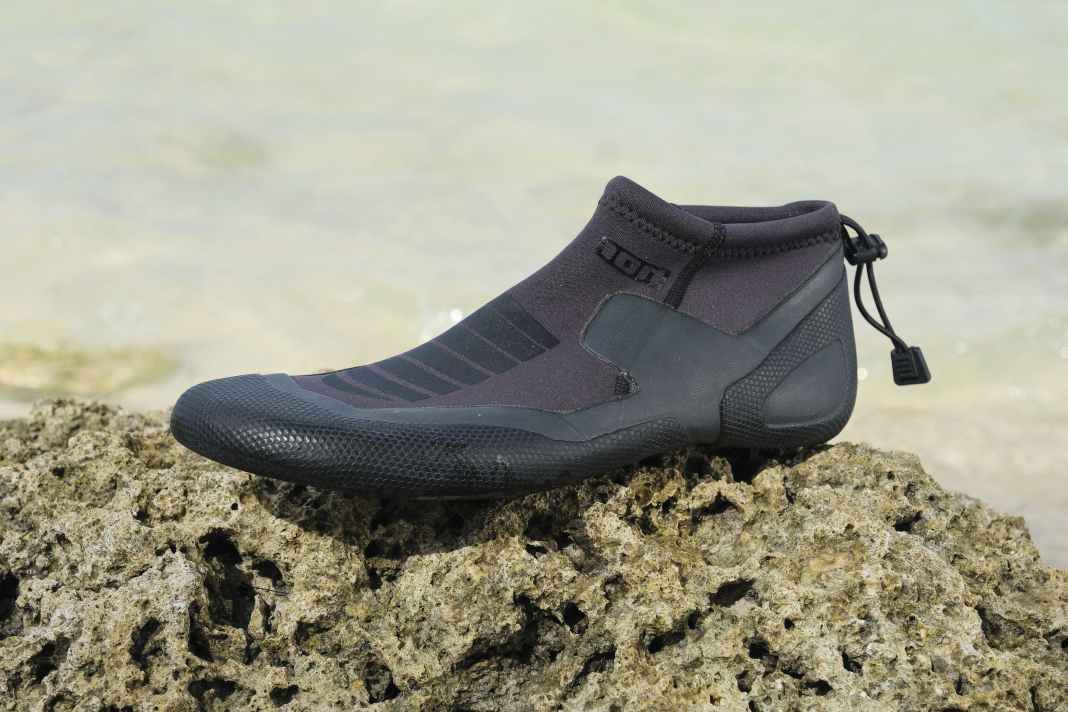



- Price: 54,99 >> available here
- Neoprene: 2.5 mm
- Sizes: 36 - 47/48
The ION Plasma was the testers' favourite. Even without a Velcro strap, with just a hint of reinforcement around the ankle, the shoe sits perfectly on the foot, nice and tight but without constricting. The simple sole offers good protection from stones and shells, but at the same time still offers plenty of feel for the board. The thick rubber is wrapped a little around the toes so that they are well protected, at least in the front area. The heel is also sensibly reinforced, while the stripes on the instep are more of a visual gimmick. The elasticated cuff keeps water and sand out as far as possible, but is unnecessarily long. The ION is one of the more expensive models in the test, but is a real recommendation for anyone who surfs with shoes on all the time.
Very good fit and hold, good protection
-
-
NeilPryde Rise Reef Round
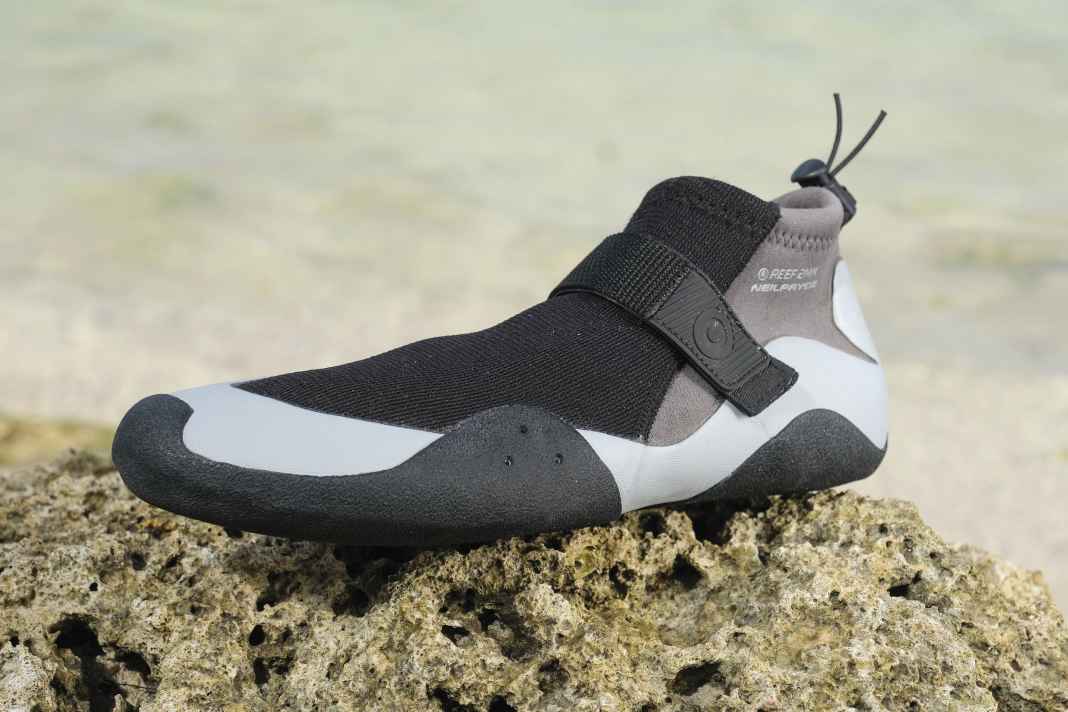



- Price: 74,95 Euro >> available here
- Neoprene: 2 mm
- Sizes: 37 - 47
Anyone who literally lives and surfs on a narrow foot should take a look at the NeilPryde shoe. The model is one of the narrowest in the test and squeezed the tester's feet uncomfortably, especially on the little toe. However, depending on the shape of your foot, this can be the decisive plus point. The many reinforcements all around provide good protection, the Velcro strap and elasticated band work perfectly and - together with the narrow cut - prevent slipping in the shoe. Small openings on the side allow water to drain away easily. The Pryde has a mesh-like fabric on the instep, which is very comfortable in the straps and provides a great feel. The sole also offers sufficient feedback for board feeling.
Lots of feeling in the straps
Very tight at the front
-
Olaian neoprene socks 500 (Decathlon)
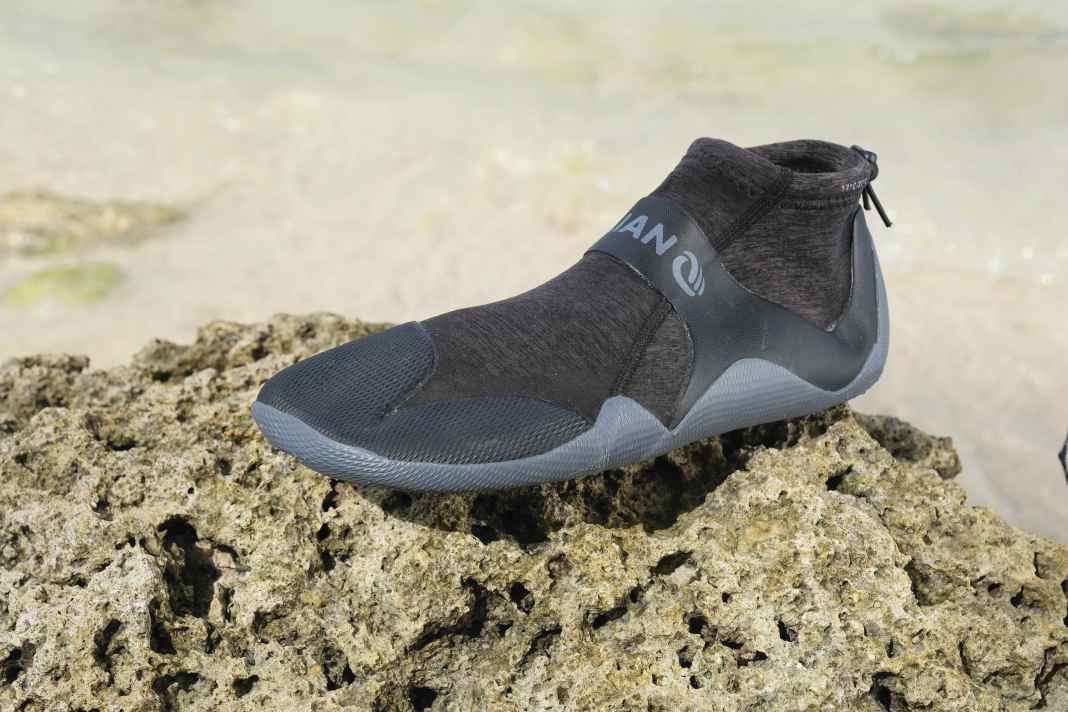



- Price: 25,99 >> available here
- Neoprene: 2 mm
- Sizes: 35/36 - 45/46
Even though Decathlon says "socks", the Olaian model has a decent rubber sole that offers sufficient protection and is also reinforced on the ball of the foot and heel - in other words, where you step when walking. At the same time, you feel enough feedback from the board. Instead of Velcro, the shoe only has a rubber reinforcement over the instep. Although this cannot completely prevent slipping inside the shoe, it still provides noticeable support. The soft neoprene on the instep is very comfortable in the straps, and the Decathlon shoe is extremely comfortable in general. There is enough space for the toes in the front area, and a little sand occasionally collects here, which gets past the elasticated cuff. The Olaian shoe also offers the best price-performance ratio in the test.
Very comfortable to wear, sole reinforced on ball and heel
-
-
ProLimit Predator RT 3 mm
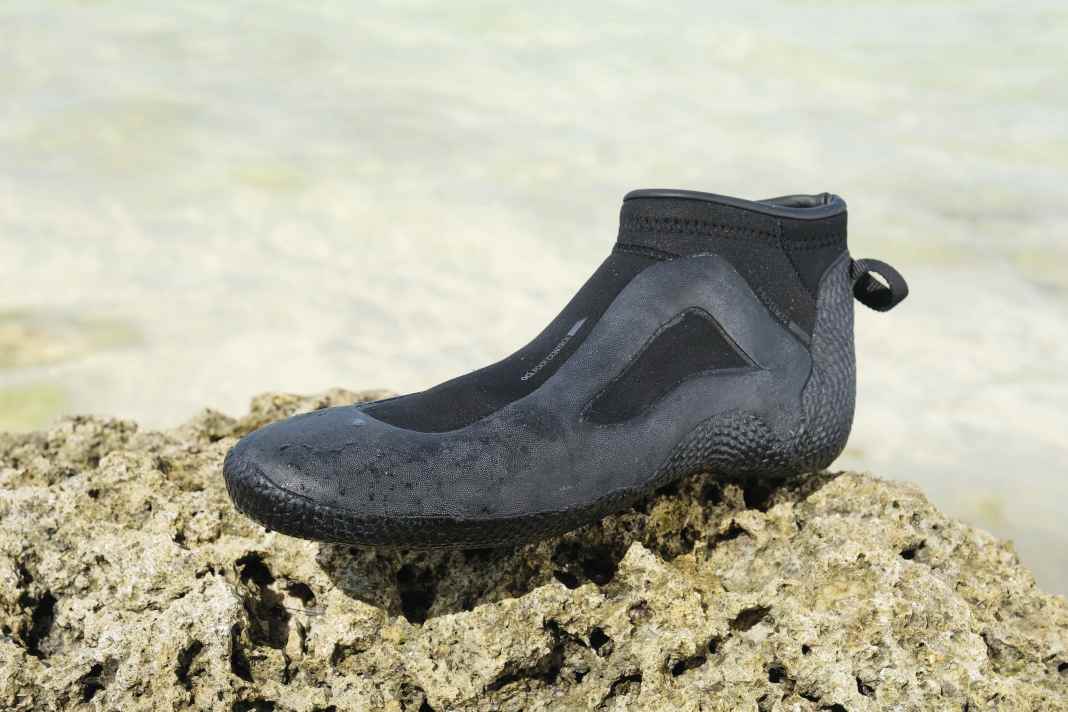



- Price: 59,99 >> available here
- Neoprene: 3 mm
- Sizes: 36 - 49/50
Without webbing and elasticated straps, the ProLimit Predator is rather simple but very robust, almost like a safety shoe. The necessary hold in the shoe is provided by a rather tight and firm fit, but it can never completely prevent the shoe from slipping around. This is certainly also due to the fact that the tester's foot still had a relatively large amount of play at the front. Water and sand kept getting in at the ankle, which is where the lack of an elasticated strap becomes noticeable. However, a strap at the heel is helpful when putting on and taking off. A surprise in view of the robust look: the sole is rather thin and provides a lot of feel for the board and the ground. It is pulled far up at the front and heel, and the side reinforcement on the outer sides protects against unpleasant foil encounters.
A lot of feeling
always some slipping around in the shoe
narrow cut
ProLimit Hydrogen RT 3
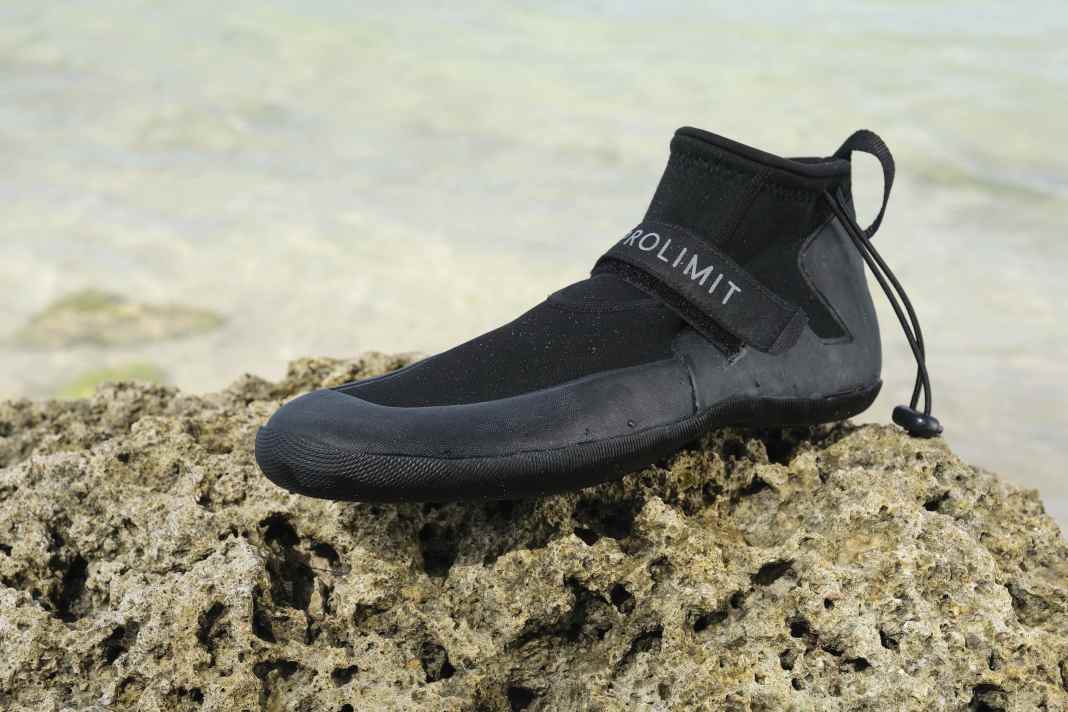



- Price: 55,00 >> available here
- Neoprene: 3 mm
- Sizes: 37/38 - 46/47
Unlike its "brother", the Hydrogen comes fully equipped with Velcro, elasticated straps and a large strap at the heel. As a result, it impresses both in terms of support and ease of slipping in; however, sand and water are not completely kept out despite the medium-high shaft. The long elasticated strap is positioned at the side to minimise interference when launching into the water. The shoe sits snugly but comfortably on the foot; it is one of the narrower-cut models, but is by no means constricting. The Velcro strap allows for customised adjustment. The sole offers a good compromise between protection from stones and sufficient feel for the board; as with the other ProLimit model, it is sufficiently raised at the heel and toe.
Good fit, good sole
-
Narrow cut
Soöruz Low Boots Fly
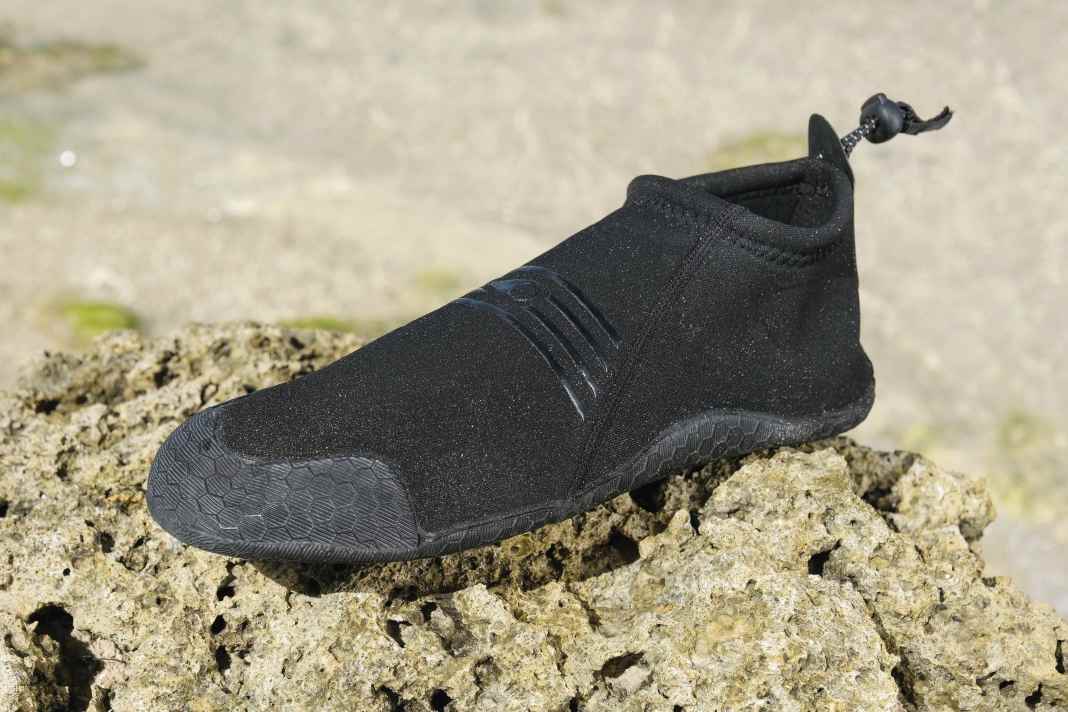



- Price: 34,86
- Neoprene: 2 mm
- Sizes: 40/41 - 45
The Soöruz shoe is more reminiscent of a sock, it is largely made of neoprene and the sole is only slightly turned up at the toes. This naturally makes it easy to put on and initially very comfortable to wear. The shoe is light and very flexible. However, after the first few steps on land or in the water, you realise that the thin sole offers little protection, sharp stones can only penetrate the feet with minimal cushioning, and despite the elasticated strap, a little sand always trickles in. The soft sock also gives the foot little support to the side and forwards on the board. When slipping into the straps, the shoe regularly twists on the foot and sometimes the sole even rolls up under the toes.
Lightweight and flexible
Little grip, very thin sole
-
XCEL Men's Infinity Split Toe




- Price: 75,00
- Neoprene: 1 mm
- Sizes: 5-13
The XCEL shoe stands out visually: the sand-coloured rubber sole makes the XCEL shoe stand out from the black neoprene allure, and there are plenty of reinforcements all around. Keyword stand out: Due to the relatively thin sole of the Reef Boot, you can feel pretty much exactly when you step on a shell or a stone - injuries are prevented, but the shoe is still close to the barefoot feeling. The separated big toe is quite far away from its four smaller counterparts, with the sole forming a kind of webbing in between. Overall, the XCEL fits the tester's foot like a glove, threading in and out of the straps is easy and the foot only slips around a little in the shoe. A premium model at a premium price, but it doesn't offer as much protection as other test candidates.
Good fit
Thin sole
-
Two more test models from Atan and Wetty have been ordered, the test impressions will be added here as soon as the shoes have been tried out!

